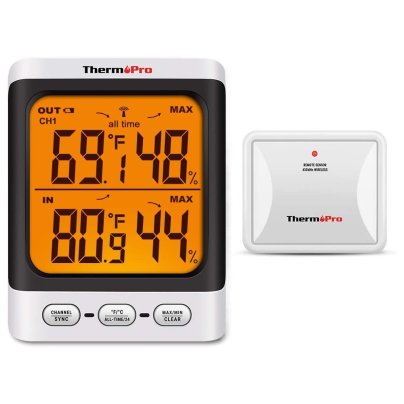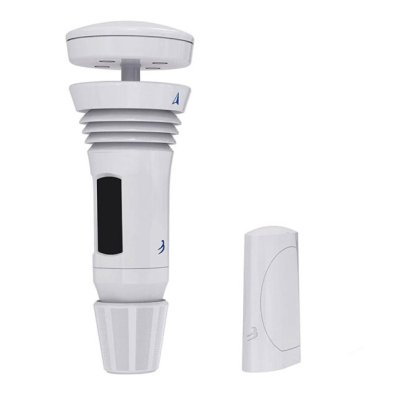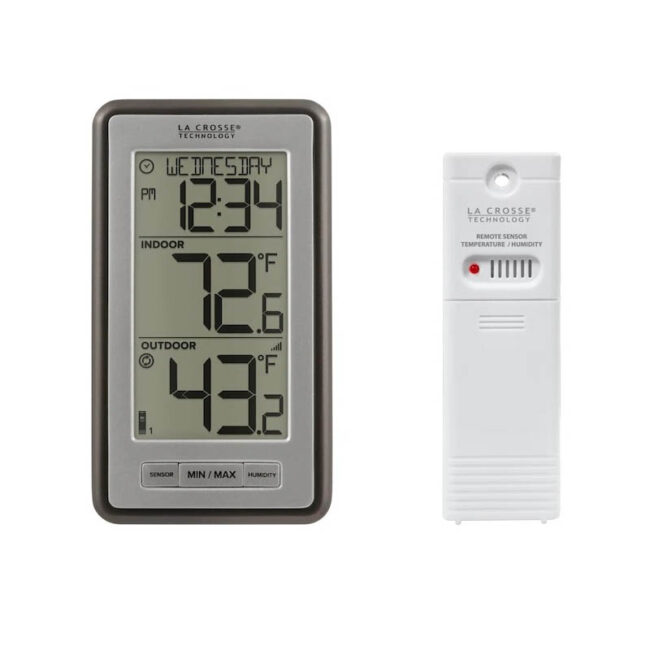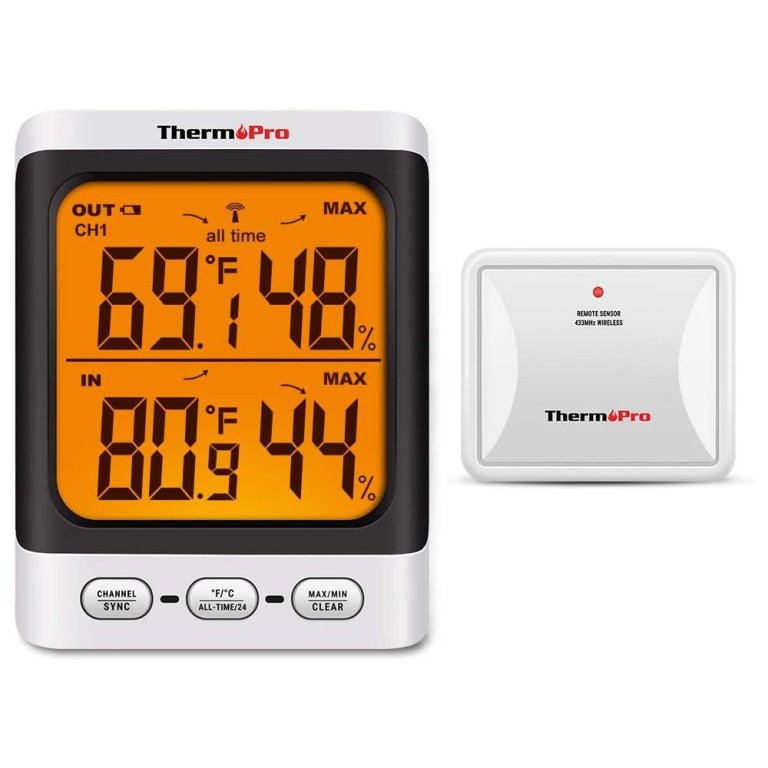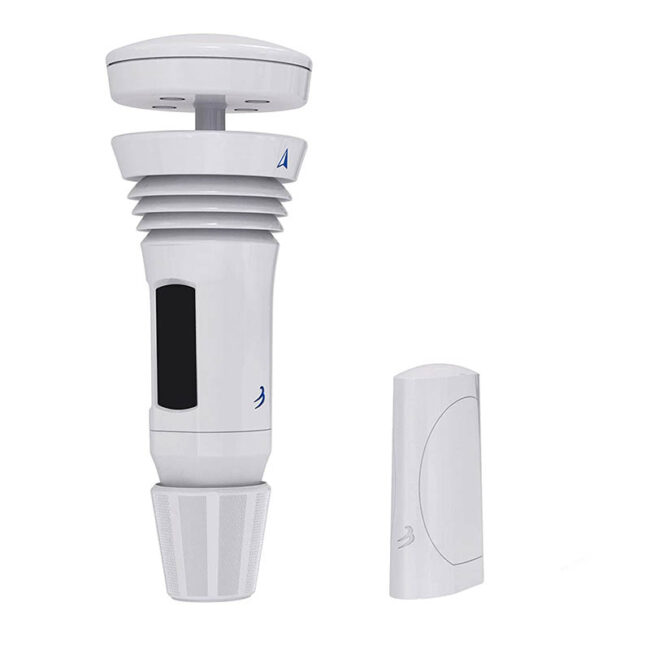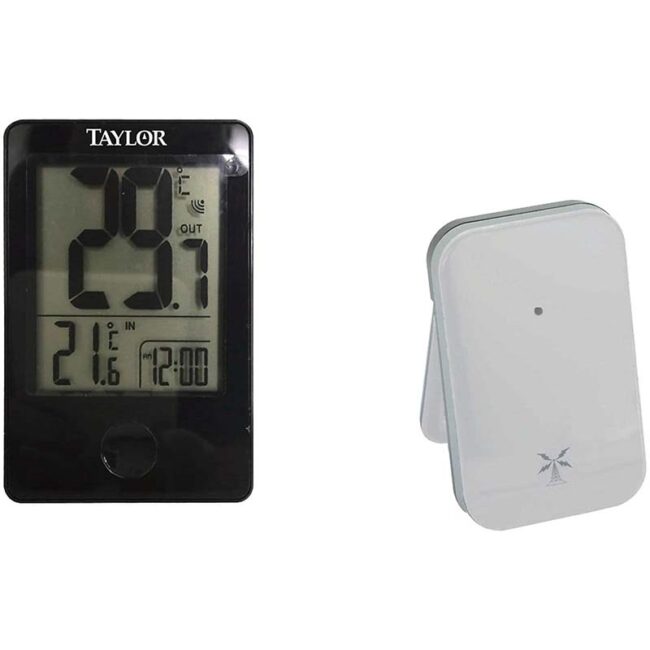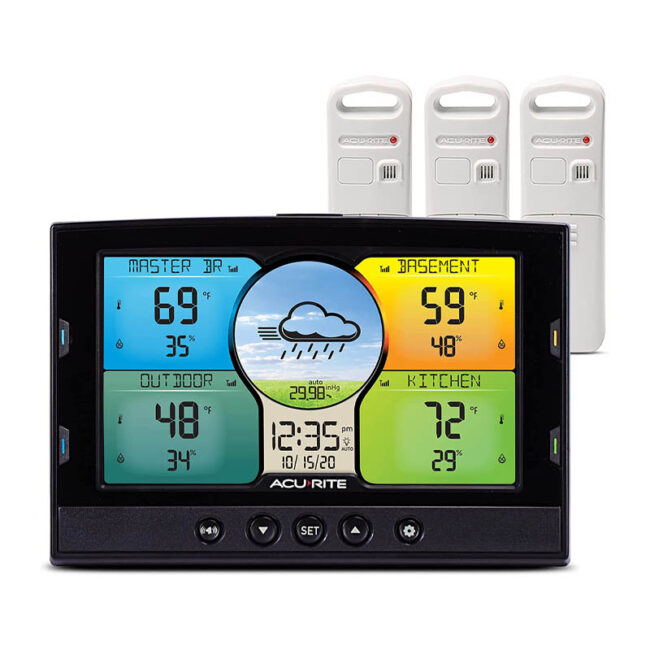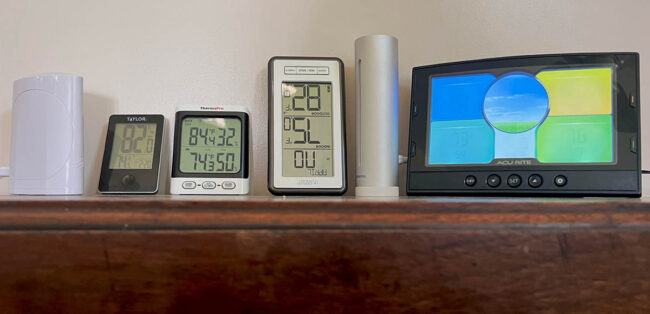
We may earn revenue from the products available on this page and participate in affiliate programs. Learn More ›
While a peek outside or a glance at a smartphone’s weather app provides all the weather information many people want, others desire more hyperlocal weather data. An outdoor thermometer or weather station can provide detailed information so you can decide if it’s a good day to work in the garden, set out on an outdoor adventure, plan a backyard barbecue, or stay inside and read a good book. To figure out which are the best outdoor thermometer options, we field-tested a variety of the most popular models, which range from simple to feature-packed.
For many people, a basic device that simply measures outdoor temperature is all that’s needed. However, today’s outdoor thermometers—often called weather stations—include wireless multipurpose devices that also display humidity, wind, and other atmospheric data. Many connect through Wi-Fi, and some operate via sophisticated phone apps that make information viewable away from home while also offering notifications and alerts.
There are a dizzying number of home outdoor thermometers and weather stations from which to choose. We talked to a weather expert to gain further insight into these handy tools, then tested a variety of options from the most basic to more sophisticated models with multiple features. We considered ease of installation and use, transmission range, accuracy, features, and display clarity.
Keep reading to learn more about the key features to consider when shopping for an outdoor thermometer, and check out the detailed reviews from our hands-on testing of some of the best outdoor thermometers.
- BEST OVERALL: La Crosse Technology Digital Weather Station
- BEST BANG FOR THE BUCK: ThermoPro TP62 Digital Wireless Hygrometer
- UPGRADE PICK: WeatherFlow Tempest Weather System
- EASIEST TO READ: Taylor Wireless Indoor and Outdoor Thermometer
- BEST MULTI-ZONE MONITORING: AcuRite Multi-Room Temperature and Humidity Station
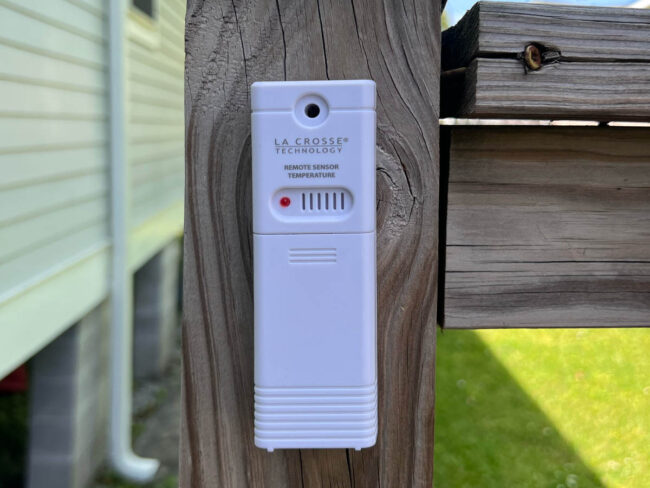
How We Tested the Best Outdoor Thermometers
Before testing our lineup, we interviewed broadcast meteorologist Cheryl Nelson, owner of travel and natural disaster preparedness website Prepare with Cher, which is based in Norfolk, Virginia. Her advice? “Keep in mind that weather reports at official stations are issued once an hour. If you have an outdoor thermometer at your home, you will have minute-by-minute temperature readings.” She adds that “this is especially important when a cold front moves through your area, where temperatures can sometimes drop 15 degrees Fahrenheit within the first hour.” With this in mind, we looked at the top-rated outdoor thermometers on the market and put them to the test for our review.
To ensure equal testing conditions and to test the wireless connectivity, we installed six outdoor thermometers about 1 foot apart on a covered porch. This location was approximately 30 feet away from the indoor room where we placed the hubs. Additionally, we tested the wireless connectivity of the devices from an open area of a backyard about 70 feet from the house.
We tested the thermometers in New Orleans, Louisiana, from mid-March through mid-April, when the area was experiencing weather and temperature fluctuations from low 60s to high 80s with varying amounts of humidity.
We periodically checked the temperatures at different times of the day to compare readings between the products. We also compared the indoor temperature data to the temperature displayed on the home thermostat. The stations reported readings within a few degrees that corresponded closely to the home thermostat’s reading.
For devices offering a forecasting function, we compared their information to the National Weather Service forecasts and found each reported similar data. For stations displaying the historical minimum and maximum weather (beginning from the installation date), we noted that their reported temperatures were also within a few degrees of each other and the national weather reports.
Our Top Picks
We researched a variety of outdoor thermometer options on the market and then tested, compared, and reviewed according to our top shopping considerations. Among the thermometers we tested, those on this list stood out for accuracy and functionality as well as ease of installation and use.
Best Overall
La Crosse Technology Digital Weather Station
Pros
- Easy-to-read display
- Prominently displays time and date
- Minimal setup
Cons
- Senses only indoor humidity
- Need to click the “Min/Max” button several times for indoor/outdoor readings
- No backlight feature
Product Specs
- Key features: Indoor-outdoor temperatures and humidity, minimum/maximum temperature recall, Wi-Fi strength indicator
- Dimensions: Display is 3.35 inches by 5.91 inches / Sensor is 1.5 inches by 5.125 inches
- Transmission range: Up to 330 feet
The La Crosse thermometer combines convenient technology with an easy-to-read display. With its 330-foot range and two sensors, one for outdoors and one on the display unit that records indoor temperature, it’s easy to simultaneously monitor both indoor and outdoor temperatures. To test this model’s accuracy, we compared the outdoor reading to the National Weather Service readings and the indoor reading to the one displayed on our home thermostat. Both the indoor and outdoor readings were within a degree or those displayed on our other devices.
The La Crosse displays time in either 12- or 24-hour cycles, and both indoor and outdoor temperatures can be set to either Fahrenheit or Celsius. Its relatively small display unit (5.91 inches by 3.35 inches) is unobtrusive and can stand on a counter without gobbling up space, yet the 1-inch digits are easy to read. We really appreciated that the La Crosse hub displayed a Wi-Fi signal-strength indicator. This model’s simplicity, consistency, and easy-to-read display boost it to the top of this list.
Get the La Crosse outdoor thermometer at Lowe’s.
Best Bang For The Buck
ThermoPro TP62 Digital Wireless Hygrometer
Pros
- Requires minimal setup
- Easy-to-read display
- Senses both indoor and outdoor humidity
- Has backlight feature
Cons
- Backlight only illuminates for 10 seconds
Product Specs
- Key features: Indoor-outdoor temperatures and humidity, backlit display
- Dimensions: Display is 3.25 inches by 4 inches / Sensor is 3 inches by 2.5 inches
- Transmission range: Up to 200 feet
The ThermoPro digital thermometer offers a wide range of readings and an easy-to-read backlit display. It comes with one sensor but offers the option of adding two so users can track several places inside or outside a home from a single display unit. We like that such a small display features both indoor and outdoor humidity readings. Our test results showed accurate temperature readings from a few different locations. We think its 200-foot range would be sufficient for most properties but not for those who need readings from a wider distance.
A tap of a finger at the top of the monitor turns on an orange backlit display to make the numbers highly visible even in the dark. This is a helpful feature; however, the backlight only stays lit for 10 seconds. The ThermoPro model doesn’t have a time and date display and doesn’t track the minimum and maximum temperatures, but it offers easy-to-read temperature and humidity readings in a handy compact size display unit for a reasonable price.
Get the ThermoPro outdoor thermometer at Amazon.
Upgrade Pick
WeatherFlow Tempest Weather System
Pros
- Smart app with machine learning
- Google Home– and Alexa-enabled
- Lots of advanced features
- Sleek indoor hub
Cons
- Installation instructions could be easier
Product Specs
- Key features: Remote operation with smart app; minimum/maximum temperature recall, indoor-outdoor temperatures and humidity, solar radiation, UV index, barometric pressure, wind speed and direction, dew point, lightning strikes, rainfall
- Dimensions: Hub is 4 inches by 5 inches / Sensor is 2.25 inches by 8.25 inches
- Transmission range: 1,000 feet
Our test results revealed that the Weatherflow Tempest Weather System is worthy of its designation as our upgrade pick. The installation instructions were clear once we figured out that we needed to twist off the bottom of the sensor’s base to access a four-digit code required to sync it with the hub. Once we did this, the rest of the installation was quick. The large solar-powered outdoor sensor (8.25 inches tall) stands upright, making it easy to place on any flat surface with no mounting required.
The Alexa integration was simple using the station’s WeatherPro app that connects directly to the Alexa app’s settings. It really is a smart app, as it uses advanced machine learning to continuously fine-tune the accuracy of its readings. The app is simple to use and easily readable, with a 7-day forecast that users tap to view hour by hour. Tapping any weather icon at the top of the screen opens to a screen displaying details about each of the atmospheric readings.
The system packs in features beyond temperature—it includes solar radiation, UV index, humidity, barometric pressure, wind speed and direction, dew point, lightning strikes, and rainfall. We loved the sleek base monitoring unit, and although it runs on AC power and isn’t portable, we felt that we were unlikely to ever need to move the base.
Get the WeatherFlow Tempest outdoor thermometer at Amazon.
Easiest to Read
Taylor Wireless Indoor and Outdoor Thermometer
Pros
- Compact size
- Easy installation
- Easy-to-read display
- Offers minimum and maximum temperature tracking
Cons
- Setup and viewing buttons small and hard to read
- Doesn’t read humidity
Product Specs
- Key features: Indoor-outdoor temperatures, minimum/maximum temperature recall, time and date
- Dimensions: Display is 2.5 inches by 3.5 inches / Sensor is 1.625 inches by 3.625 inches
- Transmission range: 200 feet
The Taylor Wireless Indoor and Outdoor Thermometer’s display unit may be small, but its digital screen isn’t. This model displays the outdoor temperature reading in large digits prominently on top and the indoor reading in smaller digits below. The small portable display unit (2.38 inches by 3.5 inches) is compact enough to place anywhere in the house. Although its 200-foot transmission range isn’t as wide as some other systems, it’s sufficient for most properties.
During testing we found the installation easy, but the setup buttons on the back were tiny and a bit hard to read. Users need to press the same small buttons several times to view the minimum and maximum temperatures or to change the display from Fahrenheit to Celsius. We did like that such a compact unit could fit an easy-to-read clock on its small display.
Get the Taylor outdoor thermometer at Amazon, Ace Hardware, or Walmart.
Best Multi-Zone Monitoring
AcuRite Multi-Room Temperature and Humidity Station
Pros
- Color-coded bright, backlit display
- Comes with 3 sensors for different zones
- Easy to read
- Has programmable audible and visual alerts
Cons
- Hard to access the sensor channel program buttons
Product Specs
- Key features: Multi-zoned with three sensors, three backlight settings, indoor-outdoor temperatures, humidity, minimum/maximum temperature recall, barometric pressure readings, weather forecast, time and date
- Dimensions: Display is 8.125 inches by 5.5 inches / Sensor is 1.5 inches by 5 inches
- Transmission range: 330 feet
This AcuRite thermometer offers incredible usability with a very large and attractive color-coded screen. It comes with three sensors that track both temperature and humidity outdoors, and the display unit contains a sensor that monitors the room in which the unit sits. Each sensor needs to be set to either an A, B, or C channel to sync it with the display monitor.
We found that the channel button location, inside the battery compartment under the batteries, wasn’t easy to find. The good news is that the accompanying instruction manual was very clear. Each sensor has a designated color-coded area on the screen, and there’s a selection of 40 preset location names for each.
For each sensor, users can program audible and visual alerts if the humidity or the temperature drops out of the set range. This model is a true environmental station at-a-glance, offering barometric pressure readings, a weather forecast, time, and date. Its large display and multiple color-coded monitored areas makes it very easy to read from a distance, with four backlight brightness settings: high (the default), medium, low, and “auto dim.” The monitor is AC-powered, but it also offers an optional battery backup. We also really like that the sensor has an opening at the top that makes it easy to hang right over a hook.
Get the AcuRite outdoor thermometer at Amazon, Lowe’s, or The Home Depot.
ALSO TESTED
Netatmo Smart Home Weather Station
We also tested the Netatmo Smart Home Weather Station, but it was difficult to set up. The system gets lots of points for its beautiful design, and we hoped the functionality would measure up to the design, but unfortunately the installation was so difficult that we couldn’t recommend it.
To begin installation, an app needs to be downloaded and then registered before the setup process can begin. We scanned the QR code on a card included in the package that was supposed to take us directly to an Apple HomeKit app for iOS phones or to the Google Play store for the Android app. The QR code worked for the Android but never worked for the iPhone. Ultimately, after several tries and workarounds, we were able to connect on the iPhone, but since the unit had been pre-registered on the Android, that user needed to invite the “additional” iPhone user to join the household.
Once we were able to access the app, it was pretty simple to use and offered loads of features, including an interactive map for viewing the weather anywhere in the world. The system senses and displays temperature and other data, including humidity, barometric pressure, CO2, and ambient sound (it was correct when it showed it was quiet, but we already knew that).
Jump to Our Top Picks
What to Consider When Choosing an Outdoor Thermometer
These days, outdoor thermometers are available in a wide range of options, from simple analog varieties that only display the temperature to digital models with multiple weather-related features. The following are some of the most important considerations when searching for the best outdoor thermometer for your needs.
Type
While there are two main types of outdoor thermometers, analog and digital, thermometers can fall into several categories. Some of the designs and displays may work better for you.
Analog thermometers include two types: the retro type and the bimetallic strip.
- The retro is the classic garden thermometer, which is a vertical glass tube filled with thermosensitive liquid.
- The bimetallic strip or round dial type has a metal needle that points to the temperature marked on a circular scale.
Digital or electronic thermometers provide more precise and accurate readings. Their displays are usually easier to read, and many offer additional weather information. While all digital thermometers need to be placed out of direct sunlight and need protection from the elements, one can choose either a direct reading or a remote reading digital outdoor thermometer.
- Direct reading outdoor thermometers measure and display the temperature on the thermometer. For accurate temperature readings, they need to be between 4 and 6 feet off the ground in a spot with adequate airflow. Locating them under the eave of the house or on a covered porch is ideal.
- Remote reading outdoor thermometers transmit data wirelessly from an outdoor sensor to a remote indoor display unit that may be several hundred feet away. In addition to temperature, many systems have multiple sensors for measuring barometric pressure, ozone levels, the UV index, wind speed and direction, and rainfall.
Some have large backlit displays that double as clocks, and may include features such as a 7-day weather forecast or memory function to record minimum and maximum temperatures over a designated period. Advanced models operate via a smartphone app that can deliver notifications. On the downside, they depend on a stable wireless connection, and obstacles can interfere with transmission of data.
Display
A display’s value comes down to readability. The measurement marks on an analog thermometer can sometimes be difficult to read. Digital displays often offer better lighting and take the guesswork out of determining the temperature. For improved readability at night, some of these displays offer backlighting with white numerals on a dark background.
Size also makes a difference. Analog displays need to be bigger to be readable from a distance, but even small digital thermometers can be easy to read.
Transmission Range
For remote reading digital thermometers, the transmission range refers to the distance a signal travels from the sensor to the display unit or hub. The indoor display needs to be within range of the sensor. Some have a range of only a few feet, while others offer a range of 200 to 1,000 feet. Models with a longer transmission range let users track the temperature in locations farther away from the house.
Some remote reading models are multi-zoned with two or three sensors to monitor conditions in different outdoor locations or indoors in rooms like a basement or attic.
Temperature Units
Most thermometers offer Celsius and Fahrenheit settings, though some may only have one or the other. Analog models often have side-by-side Celsius and Fahrenheit temperature units, while digital models let users switch between the two.
Functionality
At its most basic, the best outdoor thermometer provides an accurate reading of outdoor temperatures; however, many of today’s models offer much more. Some include several sensors that measure both temperature and humidity along with memory features that enable users to track patterns in the environment around a home. Many digital models also display the time and date, and some offer alerts and audible alarms if the temperature or humidity falls out of a preset range.
Programming and Calibration
Although most models do not need to be calibrated, some thermometers may require calibration when they’re first set up and periodically thereafter to make sure their readings are accurate. Follow the instructions in the owner’s manual for how and when to calibrate a thermometer.
If there aren’t any calibration instructions, try using one of two methods. The “ice-point method” is the quickest and most accurate. Fill a glass with ice and tap water, let it sit for 3 to 5 minutes, then insert the thermometer’s probe into the water. It should reach 32 degrees Fahrenheit and 0 degrees Celsius.
The “boil-point method” is another option; however, there’s a risk of scalding, and the boiling point is affected by elevation, which can throw off the calibration. Bring a pot of water to boil and insert the thermometer’s probe. It should match the known boiling point, which at sea level is 212 degrees Fahrenheit or 100 degrees Celsius.
Some thermometers let the user calibrate the readings for accuracy, while others don’t. With those that don’t, it’s important to know how far off the readings are and mentally adjust the temperature based on the thermometer’s setting.
Models with front-facing controls are easier to program because any adjustments can be made while the thermometer is mounted or on a tabletop.
Battery Life
Check what kind and how many batteries the thermometer needs. Digital models with multi-zone sensors usually need the most batteries because often both the display and sensors use them. It’s best if the devices have a long battery life. Many thermometers are small and efficient enough to only need replacement batteries every few months to a year. However, weather conditions and how the thermometer is used can affect the battery life.
Some models connect to an electrical power source and only use batteries for backup. Simple analog garden thermometers don’t require batteries because they rely on the laws of physics to measure temperature.
Smart-Home Integration
Digital weather stations often have a smart-home integration capability. As long as they run on the same Wi-Fi network as other devices, these thermometers can connect to a digital assistant like Google Assistant or Amazon Alexa. From there, users can use voice control to monitor the environment in and around a home.
FAQs
Tracking temperatures lets you plan your outdoor activities, take better care of a garden and yard, and dress for the weather. However, there are a few tricks to their use and setup, so there may be a few lingering questions. Below are answers to some of the most popular questions about outdoor thermometers for the home.
Q. How do I know that my outdoor thermometer is accurate?
Perform an ice-point or boiling-point test. The ice-point test involves putting the sensor or probe in a cup of ice water. It should display 32 degrees Fahrenheit or 0 degrees Celsius. The boiling-point test works the same way. Boil a pot of water and place the thermometer’s probe in the water. Then, compare the readings to the known boiling point of your altitude. Keep in mind that altitude and air pressure can alter the freezing and boiling points.
Q. Can you adjust an outdoor thermometer?
Outdoor thermometers can usually be calibrated to make sure they’re providing accurate readings. With some, you may simply adjust the dial to match the results of an ice-point or boil-point test. Digital models may offer a way to adjust the readings according to an ice-point test, or they may have a reset button that calibrates the thermometer back to digital settings.
Q. What is the best place to put my outdoor thermometer?
Try to place the thermometer somewhere where the readings won’t be altered by landscaping, the sun, or the weather. For example, it should be between 4 and 6 feet off the ground and at least 20 feet from concrete. Concrete reflects heat, causing the temperature to rise.
Outdoor thermometers and sensors don’t belong in full sun. Direct sunlight can cause higher temperature readings that don’t match the actual air temperature. Finally, try to place the thermometer where it has a degree of protection from rain.
Meet the Tester
Robin Horton has several decades of experience in the design industry, having worked with leading firms around the world in places such as New York City and Zurich, Switzerland. As the founder and creative director of the award-winning “Urban Gardens” blog, Robin has experience with all things outdoors, which allows her to provide a unique and creative perspective in her work at BobVila.com.

